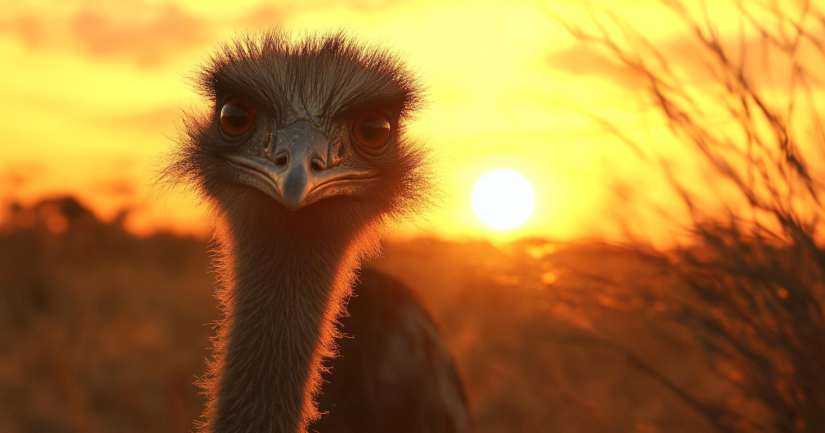
Are you curious about emus, This Emu Quiz ,How Well Do You Know Australia’s Iconic Flightless Bird? Emus are among the most fascinating birds in the world. This Emu Quiz will challenge your knowledge of these unique, flightless birds that roam the vast landscapes of Australia. As the second-largest bird by height, emus are built for speed and endurance, with powerful legs that allow them to sprint across open plains. Unlike most birds, they lack the ability to fly but make up for it with remarkable adaptability and survival instincts.
Standing up to 1.9 meters (6.2 feet) tall, emus are second only to ostriches in size. Their long, strong legs allow them to reach speeds of up to 50 km/h (31 mph), making them one of the fastest running birds. Unlike many avian species, emus have vestigial wings, which serve little purpose in flight but help with balance while running.
Intrigued by emus? Spread your wings further by exploring the mighty Eagle Quiz or waddling into the aquatic world of the Duck Quiz.
Start the Emu Quiz Now
What Makes the Emu Unique? Key Facts for the Emu Quiz
Another fascinating feature of emus is their double-shafted feathers, which provide excellent insulation. These coarse, shaggy feathers help regulate body temperature, a crucial adaptation for surviving in Australia’s harsh climates. Whether in arid deserts or coastal regions, emus rely on their ability to travel long distances in search of food and water.
Where Do Emus Live? Understanding Their Habitat
Emus are highly adaptable and found across most of mainland Australia. They thrive in open woodlands, grasslands, and semi-arid regions, where they can roam freely in search of food. Water availability plays a crucial role in their distribution, as they need regular access to drinking sources.
Despite their ability to survive in extreme conditions, emus prefer areas with ample vegetation. They feed on a diverse diet, including seeds, fruits, flowers, and insects. Seasonal changes affect their movement patterns, often leading them to migrate in search of more abundant food sources. This mobility helps maintain balance in local ecosystems, as they contribute to seed dispersal by consuming and spreading plant material.
How Do Emus Reproduce? The Unusual Role of Males in Parenting
Emu reproduction is highly unusual compared to most bird species. During the breeding season, which occurs in the cooler months, female emus lay large, dark-green eggs that can weigh up to 1 kilogram (2.2 pounds).
Male emus exhibit extraordinary dedication to their offspring. After laying eggs, females often leave to find new mates, while males remain to incubate the clutch. They do not eat, drink, or leave the nest for nearly eight weeks, relying solely on stored body fat. Once the chicks hatch, the father provides protection and guidance for several months, teaching them survival skills.
This unique parental behavior makes emus one of the few bird species where males take full responsibility for raising young. The survival rate of emu chicks depends on their father’s ability to defend them from predators such as dingoes and eagles.
Emus in Australian Culture and Conservation
Emus hold cultural significance in Australia, appearing in Aboriginal mythology and serving as a national symbol. They feature on the Australian coat of arms, representing progress and resilience. Indigenous Australians have long respected emus for their resourcefulness and have used their feathers, eggs, and meat for various purposes.
Despite being widespread, emu populations face habitat fragmentation and threats from human activities. In some regions, they are known to damage crops, leading to historical conflicts such as the Emu War of 1932, when the Australian government attempted (and failed) to control emu populations using military intervention.
Are You Ready to Take the Emu Quiz?
Now that you’ve explored the world of emus, it’s time to put your knowledge to the test! This Emu Quiz will challenge you with fascinating questions about their biology, behavior, and survival strategies. See how well you understand one of Australia’s most iconic birds!
Check out our FULL collection of Bird Quizzes!
Emu – FAQ
Emus are omnivorous and have a diverse diet that includes fruits, seeds, flowers, and insects. They are known to roam vast distances in search of food, often foraging in small groups. Their strong legs allow them to cover large areas, particularly in open grasslands and forests.
The breeding season for emus typically occurs from May to August. Males are responsible for incubating the eggs, which they do in a nest built on the ground. The female lays between 5 to 15 dark green eggs, and after approximately 8 weeks, the chicks hatch and are cared for by the male.
